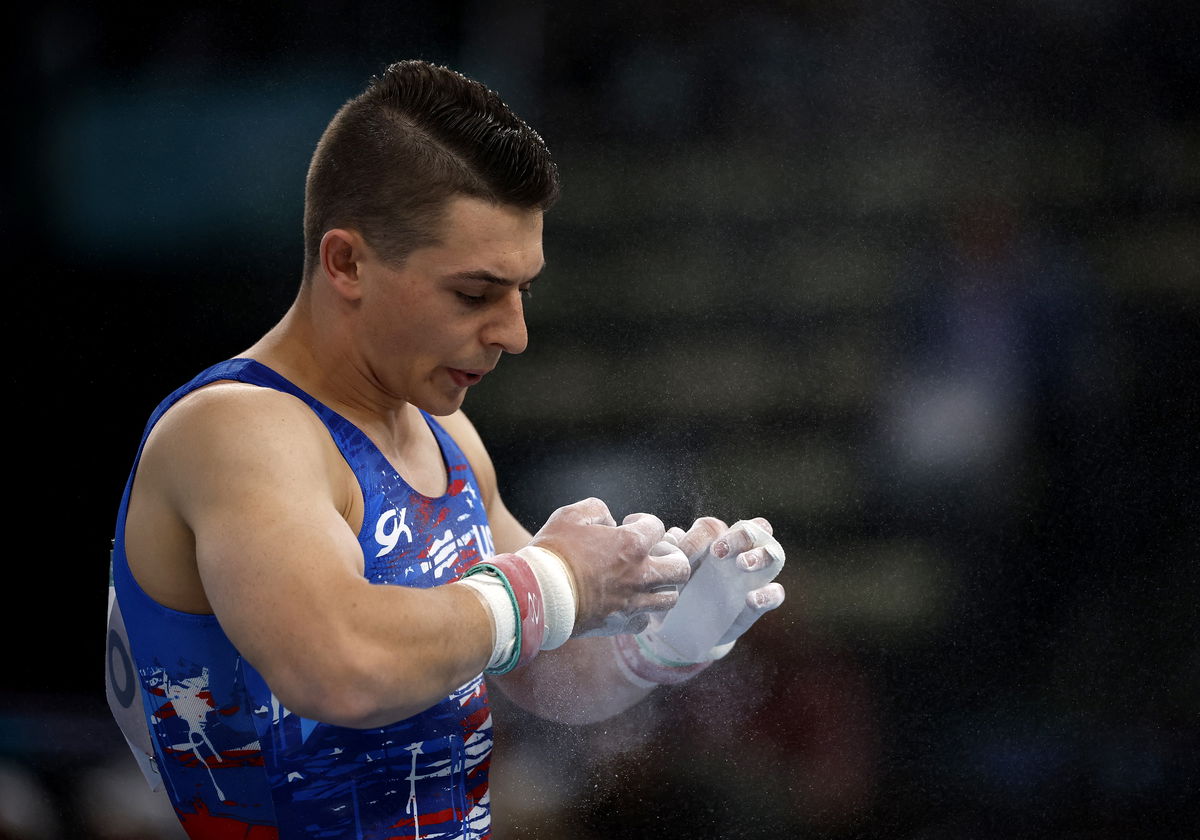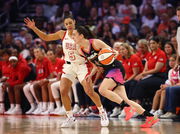
Reuters
Paris 2024 Olympics – Artistic Gymnastics – Men’s Qualification – Subdivision 1 – Bercy Arena, Paris, France – July 27, 2024. Paul Juda of United States looks on. REUTERS/Amanda Perobelli

Reuters
Paris 2024 Olympics – Artistic Gymnastics – Men’s Qualification – Subdivision 1 – Bercy Arena, Paris, France – July 27, 2024. Paul Juda of United States looks on. REUTERS/Amanda Perobelli
This time, the Michigan Wolverines have a monumental task at their hands. In the regular season, the second-best men’s gymnastics squad in the nation will host three regular-season home meets at Crisler Center. Also, the Wolverines will set up for the Big Ten Championships and NCAA Championships. Last season, Paul Juda and Fred Richard’s team fell short of 6 points (approx) to go past topper Stanford in the NCAA Men’s Gymnastics Championships. The yellow brigade doesn’t want to repeat the same issue this time. The team will return 14 gymnasts who represented the fold last season. However, at such a prime moment, Paul Juda thinks about something else.
Watch What’s Trending Now!
The 23-year-old Illinois native had a dream season last year in men’s gymnastics. In the NCAA championship, he claimed the gold medal in the floor exercise event and silver in the vault event. Later, in the Paris Olympics, Juda helped Team USA clinch the team medal in men’s gymnastics, a feat achieved by the Stars and Stripes after 16 years! Yet he thinks that nothing might solve the ongoing issues in men’s gymnastics. What are those issues?
In an exclusive with Inside Gymnastics, the Olympian spoke about the lack of income in men’s gymnastics. He opened up on the problem, mentioning an utter crisis: “We do such a unique sport. No one really understands it except for gymnasts.” However, in the next minute, he added, “I also was emphasizing to the kids, but mostly the parents, too, during a talk on tour, I said, ‘Listen, I think as gymnasts, we all are super-motivated to be really successful in the classroom because we know there’s not a lot of money in gymnastics. So, we end up pursuing more.” According to him, the issue of revenue is ageless, and winning the Olympics, World Championships, or NCAA contests will not solve it. Then? Any special route to earn money?
ADVERTISEMENT

ADVERTISEMENT
Juda spoke about ‘pursuing more.’ The lines, meanwhile, signify finding a scope to make income through other professions. How? He had his answer ready. In the conversation, Juda claimed, “I’ve got 23 teammates–and I think 11 or 12 of them are engineers. I’m surrounded by people in med school, law school, engineering, computer science, computer engineering, PhDs, all of that.” Per him, his gymnastics pals in the Michigan Wolverines have already figured out a way of making money outside of sports. A few discussions explain that except for the stipend provided by the program, the men gymnasts don’t have many chances to add numbers to their pockets in the USA.
However, the stipend sometimes falls short of covering the costs. The meager sum makes it a struggle to earn enough to live on. That is why Juda’s colleagues plan to pursue different careers after finishing their collegiate years. Juda is also thinking about following the same route. “I’m going, ‘Okay, I’ve got to do something, too,’” he said, looking resolute to embrace that ‘something.’ But apart from the lower income, there’s another issue in men’s gymnastics. Surprisingly, an electrical engineer who is a gymnast also raised a voice on that issue.
ADVERTISEMENT
Paul Juda’s teammate points out a structural problem in men’s gymnastics
Paul Juda noted the low income in men’s gymnastics at the college level. However, his Paris Olympic teammate shed light on another huge issue. Two months ago, Stephen Nedoroscik headlined once again for gymnastics. No, he didn’t attract the limelight because of his performance. Instead, his verbal protest against Ohio State’s decision to slash scholarships from men’s gymnastics became a talking point. “Ohio State removing athletic scholarships from Men’s Gymnastics. Yet again, another step backwards for MGYM. With the success of current and former NCAA gymnasts at the Olympics you’d think NCAA programs would be excited for the upcoming season, not stripping away opportunities,” he wrote in his X-post in October. A closer look may represent the picture better.

Reuters
Paris 2024 Olympics – Artistic Gymnastics – Men’s Qualification – Subdivision 1 – Bercy Arena, Paris, France – July 27, 2024. Frederick Richard, Brody Malone, and Stephen Nedoroscik of United States walk after performing. REUTERS/Amanda Perobelli
This year, the Team USA men’s gymnastics squad earned a medal in the team event at the Paris Olympics. After 16 years, they finally achieved an Olympic milestone. However, just a few weeks later, Ohio State revealed its choice to reduce the scholarship allocation for men’s gymnastics. So, from now on, there won’t be any financial help for those who register in the men’s gymnastics program at OSU. Surely, the decision will decrease footfall in the sport. And if it continues, the future of men’s gymnastics in the USA will turn dark. Not only that, according to NCAA data, there were 59 Division I men’s gymnastics programs in 1981. But the number has fallen abruptly. In 2024, it is 12, reflecting a decrease of 79.6%. Don’t these facts put bulwarks in Juda and Nedoroscik’s way of seeing a secured future as gymnasts? Do you have any takes on it?
ADVERTISEMENT
Top Stories
Cam Newton Makes NFL Return Conditions Clear to 32 Teams as Panthers Legend Confirms Retirement Stance

Caitlin Clark Shows Concerning Signs vs. Kelsey Plum During USA Camp Debut, per National Reporter

Tom Brady Makes Career Announcement for Vegas as Pete Carroll Addresses Losing Raiders Locker Room

“RIP”: Prayers Pour In as Tom Brady’s Raiders Struck by Tragedy

J. J. McCarthy Awaits Punishment From Vikings After Rejecting Kevin O’Connell’s Instructions

Kyle Tucker Slowly Slips From Toronto’s Grip After Blue Jays Legend Confirms Bo Bichette Plan

ADVERTISEMENT
ADVERTISEMENT
ADVERTISEMENT

